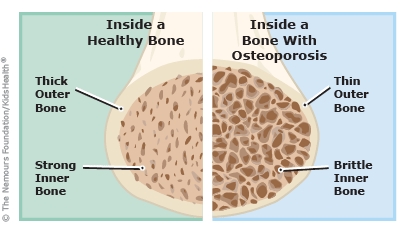Osteoporosis: How to Care for Your Child
By following their health care provider's recommendations, kids with osteoporosis (os-tee-oh-puh-ROH-sis) can strengthen their bones and reduce the risk of fractures.


Our bodies use calcium to build bones and keep the muscles and nervous system working properly. When kids don't get enough calcium from food or supplements, calcium is taken from the bones to be used by other parts of the body. Over time, this weakens the bones and can lead to osteoporosis. In this condition, the bones can break easily.
Osteoporosis is more likely to happen in kids who have chronic illnesses, limited ability to move, hormonal imbalances, or eating disorders. Certain medicines and tobacco smoke also raise the risk of osteoporosis. Occasionally, it develops even though there are no underlying health problems — this is called juvenile idiopathic osteoporosis.
Treatment may include supplements like calcium and vitamin D, which help the body take in and absorb enough calcium; medicine to help the bones store calcium; and physical therapy and exercise to strengthen the bones.

-
Give your child any prescribed supplements or medicine as directed by the health care provider.
-
Serve foods high in calcium, such as dairy products, canned salmon and sardines, fortified cereals and juice, and dark green leafy vegetables.
-
Daily weight-bearing exercise strengthens bones:
-
If possible, children who are not fully ambulatory should use a walker, gait-trainer, or standing frame (which helps them maintain a standing position) for 30–60 minutes a day.
-
Other kids can try exercises like walking, jogging, stair-climbing, and jumping rope.
-
If your child or anyone in the home smokes, call 1-800-QUIT-NOW for advice on quitting.

Below are the recommended daily intakes of calcium, phosphorus, and vitamin D for healthy children. Your health care provider may prescribe higher amounts based on your child's condition.
|
|
Ages 1–3
|
Ages 4–8
|
Ages 9–18
|
Ages 19-50
|
|
Calcium
|
700mg
|
1,000mg
|
1,300mg
|
1,000mg–1,200mg
|
|
Phosphorus
|
460mg
|
500mg
|
1250mg
|
700mg
|
|
Vitamin D
|
600IU
|
600IU
|
600IU
|
600IU
|

